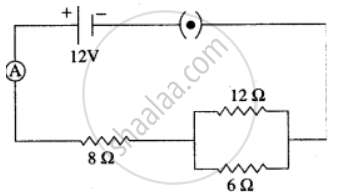Advertisements
Advertisements
प्रश्न
A potential difference of 20 volts is applied across the ends of a resistance of 5 ohms. What current will flow in the resistance?
उत्तर
Here,
Potential difference, V = 20 V
Resistance, R = 5 Ω
Substituting these values in Ohm's equation, V/I = R:
Current, I = V/R = 20/5 = 4 A
Thus, the current flowing in the circuit is 4 A.
APPEARS IN
संबंधित प्रश्न
How much energy is transferred by a 12 V Power supply to each coulomb of charge which it moves around a circuit?
If a potential difference of 10 V causes a current of 2 A to flow for 1 minute, how much energy is transferred?
Ohm's law state a relation between potential difference and ___________.
Water in the waterfall flows from a higher level to the lower level because of ____________.
Point out two differences between e.m.f. and potential difference as applied to electric circuits.
Three resistors are connected to a 12 V battery as shown in the figure given below:

(i) What is the current through the 8 ohm resistor?
(ii) What is the potential difference across the parallel combination of 6 ohm and 12 ohm resistor?
(iii) What is the current through the 6 ohm resistor?
From the following observations taken while determining the resistance of a conductor, draw the current-voltage graph and calculate the resistance of conductor. Is the conductor ohmic?
| Ammeter reading I (in ampere) | Voltmeter reading V (in volt) |
| 0.2 | 0.4 |
| 0.3 | 0.6 |
| 0.5 | 1.0 |
| 0.8 | 1.6 |
| 1.5 | 3.0 |
Five resistors of different resistances are connected together as shown in the figure. A 12 V battery is connected to the arrangement.

Calculate:
(i) the total resistance in the circuit
(ii) the total current flowing in the circuit.
If P and V are the power and potential of device, the power consumed with a supply potential V1 is:
